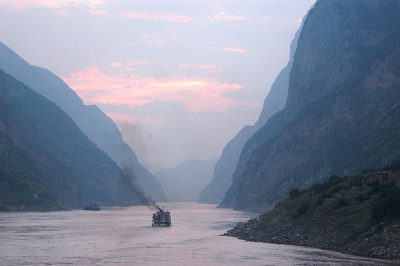China Record Heat Wave and Drought: Yangtze River Begins to Dry Up, Shooting Iodide Rods Into Sky to Increase Rains
In the wake of the record-breaking heatwaves, China is shooting rods into the sky to increase rainfall as certain places of the Yangtze River begin to dry up.

All Global Research articles can be read in 51 languages by activating the “Translate Website” drop down menu on the top banner of our home page (Desktop version).
To receive Global Research’s Daily Newsletter (selected articles), click here.
Follow us on Instagram and Twitter and subscribe to our Telegram Channel. Feel free to repost and share widely Global Research articles.
***
In the wake of the record-breaking heatwave and intense drought, China has been trying to induce rains in some parts of the nation’s central and southwest areas. According to the CNN report, Chinese planes are shooting rods into the sky to increase rainfall as certain places of the Yangtze River begin to dry up. It is worth mentioning that Asia’s longest river, the Yangtze, is currently at record low levels. Although some Yangtze River regions have started weather modification initiatives, several drought-stricken areas of the river’s basin have stayed on standby due to insufficient cloud cover.
In addition to this, on Wednesday, the Ministry of Water Resources cautioned in a notice that the Yangtze River basin’s drought has been negatively “affecting drinking water security of rural people and livestock, and the growth of crops.” Further, the Hubei province in central China announced on Wednesday that it will use ‘silver iodide rods’ to create clouds and induce rainfall.
According to the CNN report, the silver iodide rods which are basically the size of cigarettes, are fired into existing clouds to aid in the formation of ice crystals. The cloud is subsequently given a boost for producing rains by the crystals, further increasing the amount of moisture in the cloud and its likelihood of release.
Notably, China has the largest system in the world and has been using the cloud seeding technique since the 1940s. This technique may also be used to soften hail or create snowfall.
China is facing severe drought condition
As per Hubei’s Provincial Emergency Management Department, a severe drought has afflicted nearly 4.2 million people in Hubei since the month of June. Approximately 400,000 hectares of crops have been harmed by the heat and drought, and over 150,000 people there have trouble getting access to drinking water, CNN reported.
Moreover, large areas of China are experiencing unexpectedly high temperatures and a persistent drought, which are impacting agriculture output and drinking water supplies. Chinese authorities have issued alerts for temperatures above 40 degrees Celsius, and many regions of the nation have already surpassed previous records for high temperatures in 2022, Associated Press reported.
The droughts in provinces like Hubei, Anhui, Jiangxi, and Sichuan have been brought on by sustained high temperatures and a lack of precipitation since July, according to state television CCTV, which on Wednesday aired clips of dried-up soil and crops in southern China. In the meantime, temperatures in Sichuan and other regions have surpassed 40C, as per a BBC report.
Furthermore, factories in China’s southwest have closed as a result of hydropower reservoirs running low due to an intensifying drought. According to news reports published on Wednesday, businesses in the Sichuan Province, including those that produce solar panels, cement, and urea, shut down or decreased output after receiving orders to ration electricity for up to five days. That happened as reservoir levels dropped and the demand for electricity for air conditioning rose amid sweltering heat.
*
Note to readers: Please click the share buttons above or below. Follow us on Instagram and Twitter and subscribe to our Telegram Channel. Feel free to repost and share widely Global Research articles.
Featured image: Dusk on Chang Jiang (Yangtze) (By – Flickr, licensed under CC BY 2.0)

